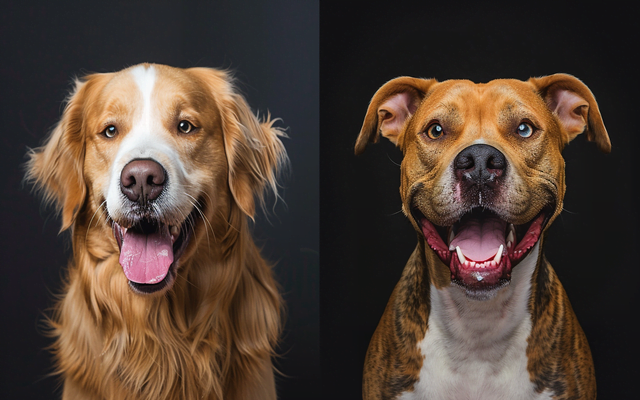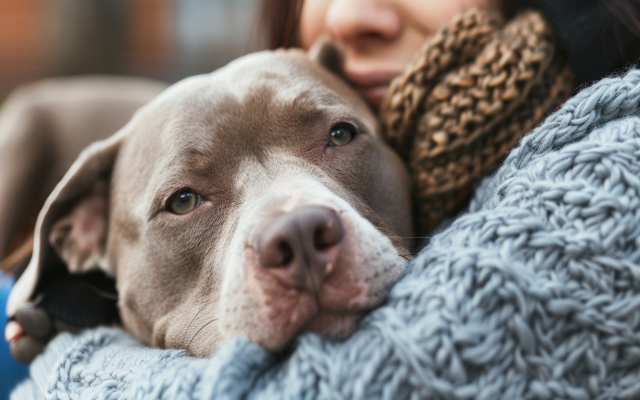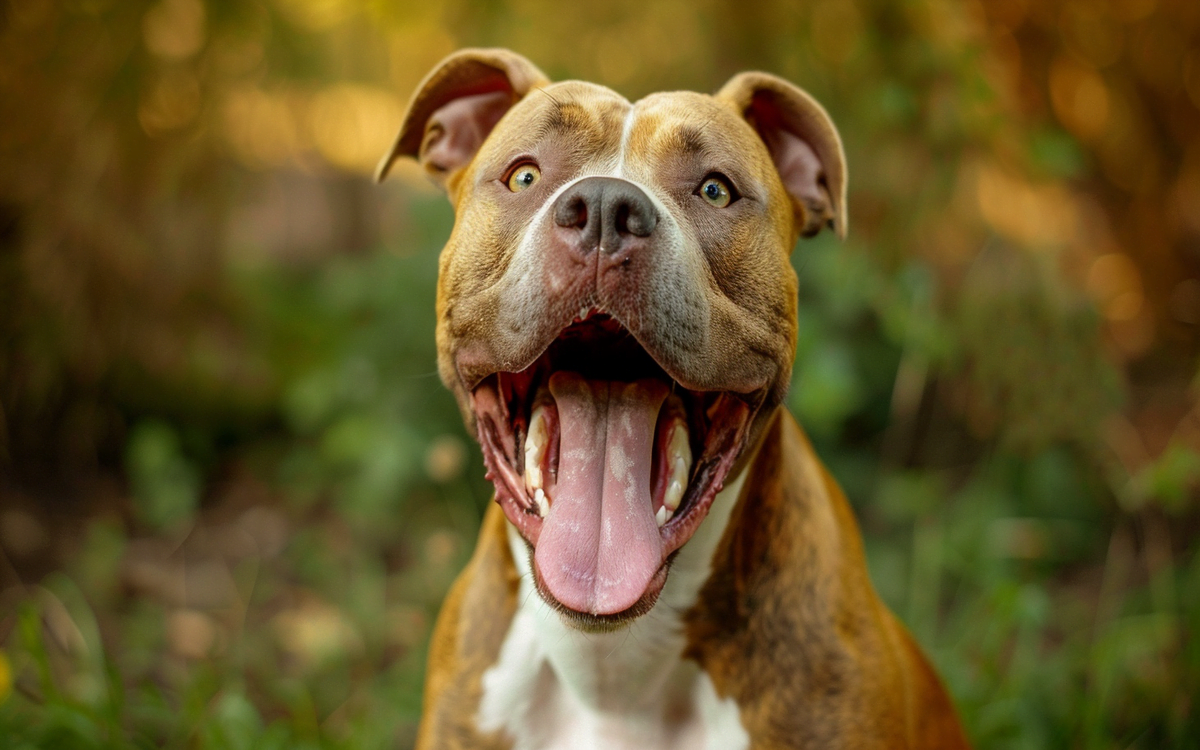Pit Bulls do not have any special physical mechanism or enzyme that allows them to “lock” their jaws. If you compare a Pit Bull skull to a skull of any other dog breed, you can see with the naked eye that both skulls share the same characteristics and general bone structure. However, one personality trait of the Pit Bull breed is determination. Whatever Pit Bulls do, they do it with a great deal of enthusiasm, and it is this trait that can make it seem like they have a locking jaw when they bite down on something and are determined not to release it.
Introduction
Did you know that a gentle Golden Retriever and a powerful Pitbull share a surprising amount of DNA? Despite their differences, a common myth portrays Pitbulls as having dangerously unique jaws. Let’s bust that myth and learn the truth about dog jaws and responsible dog ownership!
Pitbulls, along with all dog breeds, do not have jaws that lock shut. This myth is harmful, creating fear and discrimination. Let’s dive into the facts about dog anatomy, the dangers of these misconceptions, and how we can be responsible dog owners for the benefit of all pups.

Demystifying the Bite: A Look at Dog Anatomy
Jaws 101
Imagine your dog’s jaw like a pair of powerful tongs. Muscles open and close those tongs, and strong jaw muscles give some dogs a forceful bite. But, whether a Labrador or a Pitbull, there’s no latch or lock involved!
Bite Force vs. Lock
While certain breeds, including Pitbull-types, might have powerful bites, the strength comes from their build, not a locking feature. Think of it like the difference between a gentle hand grip and a weightlifter’s grip – stronger, but both rely on the same basic hand mechanics.
Evolutionary Perspective
Dogs’ jaw anatomy has evolved over time for survival basics: grabbing prey, crunching food, and defense if needed. There’s no evolutionary advantage in having a jaw that locks. If their bite locked, injured prey might easily escape, leaving a hungry dog!
The Pitbull and the Public Perception Problem
Historical Misconceptions
Sadly, Pitbull-type breeds were once misused in the cruel sport of dogfighting. This history, however unjust, contributes to the mistaken idea that their jaws are somehow different. It’s time to separate unfortunate history from facts.
Media’s Role in Shaping Narratives
News headlines often focus on breed when a dog bite occurs. Sensationalized reporting can play on existing fear and reinforce the locking jaw myth, even though any dog, big or small, can bite if provoked or poorly trained.
Myth vs. Responsibility
Pitbulls, like all breeds, need proper training, socialization, and responsible ownership. It’s essential to judge a dog by its behavior, not its breed. Blaming genetics is a cop-out – poor handling, lack of training, and irresponsible breeding practices are more likely culprits when dog aggression occurs.

The Real Culprits: Understanding Dog Bite Prevention
Dog Body Language – A Visual Guide
Let’s become dog whisperers! Dogs use their entire body to communicate. Understanding their signals can prevent fear, miscommunication, and potential bites.

Socialization is Key
Puppies need exposure to friendly people, other dogs, and new experiences. Well-socialized dogs are less fearful and therefore, less likely to act out with aggression. Think of it like learning good manners as a human kid – dogs need practice, too!
Training for Harmony
Positive training works wonders with any dog, including Pitbulls. Teaching commands, rewarding good behavior, and building a bond between dog and owner creates a safer and happier home for everyone.
Beyond the Breed
Let’s focus on fostering positive relationships with all pups, and remember, a dog’s temperament is often more important than its breed!
Beyond the Breed: Championing Responsible Dog Ownership for All
Focus on the Individual
Instead of getting hung up on labels, let’s judge each furry friend on its own merits. Some dogs, even within the same breed, have different personalities and needs. Getting to know a dog as an individual is key!
Temperament Testing
While its limitations should be noted, temperament testing can provide some insights into a dog’s personality traits. Responsible breeders and shelters often use these assessments.
Breed-Neutral Shelters
It’s heartening to see more shelters focus on a dog’s individual personality and needs rather than just breed labels. These shelters are saving lives and helping amazing dogs find the perfect homes!
Advocate for Responsible Ownership
Whether it’s a Pitbull, a Chihuahua, or a Poodle mix, all dog owners have a responsibility. Here’s what that means:
- Research: Learn about a breed’s common traits and energy levels before bringing one home. Choose a dog that matches your lifestyle!
- Training & Socialization: Essential for any dog, ensuring they are well-behaved and comfortable in various situations.
- Proper Care: This includes good nutrition, regular exercise, veterinary care, and lots of love!
Success Stories: Celebrating Responsible Pitbull Ownership
Highlighting Therapy Work
Often overlooked, many gentle Pitbulls excel as therapy dogs and emotional support animals. Their sweet, goofy personalities can bring so much joy and comfort.
Meet the Owners
A heartwarming story of a dedicated and responsible Pitbull owner can help dispel stereotypes. Share how the owner provides training, love, and care, resulting in a well-adjusted and beloved dog.

Conclusion
We busted the myth – Pitbull jaws do NOT lock! Responsible ownership practices are vital for the well-being of dogs and the safety of everyone around them.
FAQs
Why do people think Pitbulls have locking jaws?
This directly addresses the core misconception and is likely a common search query. Your answer can cover the breed’s history, media bias, and bite force vs. locking mechanism.
Can Pitbulls be trained to unlock their jaws?
A unique FAQ tapping directly into the myth’s absurdity. Your answer reinforces the lack of anatomical basis for the locking mechanism.
My Pitbull has a strong grip when playing tug-of-war. Is this a sign of jaw locking?
Leverages a common dog owner experience to clarify the difference between playful gripping and the myth, promoting a better understanding of natural dog behavior.
Why do Pitbulls have a bad reputation?
Unfortunately, a combination of factors has contributed to Pitbulls’ negative image. Historically, some irresponsible individuals exploited the breed’s strength in dogfighting. Additionally, media often focuses on breed when reporting dog bites, which can perpetuate unfair stereotypes. It’s important to remember that irresponsible owners and sensationalized news, not breed, are usually the root of behavioral problems.
Are Pitbull bites more dangerous than other dog bites?
All dog bites can potentially be dangerous. While some breeds, including Pitbull-types, may have stronger bites due to their build, bite severity depends on many factors – the dog’s size, the situation, and whether the victim receives prompt medical attention. Focusing on preventing dog bites for all breeds through responsible ownership is much more important than demonizing a specific breed.
Can I safely adopt a Pitbull if I have children?
Pitbulls, like any dog, can be wonderful companions for families with children if proper precautions and education are in place. Here’s what matters most:
- Responsible Ownership: Choose a dog with a known history, ensure it has training, socialization, and receives proper care.
- Supervision: Never leave young children unsupervised with any dog, regardless of breed.
- Teach Respect: Help children learn how to interact safely and respectfully with dogs, including reading a dog’s body language.

I’m Ashley Fowler and dogs have always been my companions from my earliest memories. Growing up, our family dog was my confidant, adventure buddy and sometimes partner in crime (sorry mom, about the chewed shoes!). That bond sparked a lifelong passion for learning about dogs – their unique personalities, their histories, and the special ways they fit into our lives. MDogsW is my way of sharing that passion and hopefully helping others experience the joy of finding their perfect puppy. When I’m not researching dog breeds, you can usually find me hiking with my trusty Beagle by my side or curled up with a cozy blanket, a cup of tea, and a stack of dog breed books.


